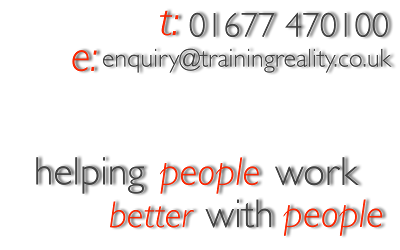Please press (at least!) one of these.
It costs you nothing, and (possibly) helps us spread the word!
93% of communication is (not) non-verbal
Tuesday, 18 August 2009
I was recently asked to come up with a few examples of “the worst 'HR consultancy speak' phrases” I’d ever heard. It was almost too easy to begin the list - much trickier to find an appropriate place to stop.
A lot of jargon, clichés, and buzzwords are used on many training courses (something we work really hard to avoid), but luckily, most people have seen enough and heard enough to spot these things coming from miles away. More insidious, and potentially more dangerous, than this is the tendency, is the tendency to present “scientific facts” to audiences, even if there is no basis for them at all.
One of the absolute classics (covered in a recent edition of Radio 4’s More Or Less) is the statement that 93% of communication is non-verbal. In the programme, Tim Hartford interviewed the academic whose research has been misrepresented by so many in this way, Albert Mehrabian.
In one study participants had to judge the positive, negative or neutral content of various words. Three were chosen to be positive - 'dear', 'thanks' and 'honey' - three neutral - 'oh', 'maybe' and 'really' - and three negative - 'brute', 'don't' and 'terrible'. Each was then read in either a positive, neutral or negative tone of voice.
In a second study participants had to judge if the word 'maybe' was positive, negative or neutral from looking at a photograph of a person with a positive, negative or neutral face. The actual (as opposed to “management training”) conclusions from this research was that tone was 5.5x more powerful in determining the participants’ judgement than the words, and that facial expression was about 50% more powerful than the tone of voice.
From this, an over-simplified conclusion has been drawn, that only 7% of (the response to) communication is based on the words, 38% is tonality, and 55% is facial expression (or more broadly, body language).
During the radio interview, he blew a hole, beautifully, through this interpretation, by explaining that if he were asked where a pencil was, he would struggle to communicate that is was in the third drawer down of the left hand side of the desk in the spare bedroom without using words.
There are a number of things that can be taken out of this wonderful little destruction of a myth:
1) Be very wary of supposed scientific data. People may be twisting data to support their own arguments (although this is sometimes pretty easy to spot), but, more subtly, they may be regurgitating things they have heard themselves, without going back to the source and truly understanding it.
2) Understand that communication is terrifically, beautifully complex, and that developing communication skills is a lifetime’s work, not a 10-step programme or a quick training course fix. Of course, having the opportunity to take time to look at communication in detail and work with others on it is fantastic, but it will not fix everything instantly.
3) Equally, don’t forget that, however ridiculous the “93%” statement is, that the experiments (and common sense) does show that the non-verbal parts of communication are extremely important, and that, allied with the verbal aspects, can change, alter, or strengthen the message that you are trying to get across.
4) Be aware that not everyone in the management training industry applies common sense themselves - there are (unfortunately) a few who insist on mis-applying over-simplified pop-psychology and presenting themselves as enlightened gurus while they do it!
---
If anyone has further examples of some of the nonsense spread throughout the HR and management training industry, or have personal experience of it from training courses they’ve been on, I’d be delighted to hear about it.
Please press (at least!) one of these.
It costs you nothing, and (possibly) helps us spread the word!





